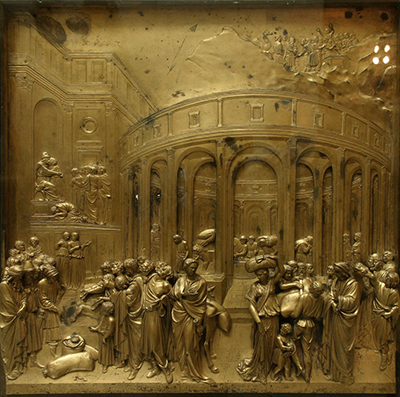This busy panel design is a feast for the eyes, with artist Lorenzo Ghiberti providing interest right across this gilted bronze artwork
This artwork links directly to the afore mentioned Jacob and Esau with the mothers featured in that panel producing sons (twelve in total) who appear here in this Joseph panel. The book of Genesis features Joseph more than any other, covering his birth and stories from his subsequent years in unrelenting detail. It is Joseph's relationship with his brothers that provides the most turmoil and this explains why they all appear in this panel piece.
Joseph Sold into Slavery again displays the artist's understanding of perspective and he would use this to draw out his panels into a more three-dimensional look. To have these bronze panels lean out towards the viewer would no doubt lift the viewer's initial reaction to such a stunning piece, when arriving at the completed bronze doors. Famously, Michelangelo nicknamed them the Gates of Paradise.
Renaissance architecture involved a wealth of impressive contributions, with much of Lorenzo Ghiberto's work being from the angle of a sculptor rather than someone who would design entire buildings. This art period was also well known for the versatility of it's artists, who would often specialise in several different mediums - see Michelangelo, for example, who put significant work into sculpture, poetry and painting, whilst another Renaissance Man, Leonardo da Vinci, produced paintings and inventions.
Two further members of the Renaissance who were also well known in the field of architecture were Giotto di Bondone and also Filippo Brunelleschi. The former worked on some of the most prominent items in this early period, such as Scrovegni Chapel, Giotto's Campanile and Florence Cathedral.




